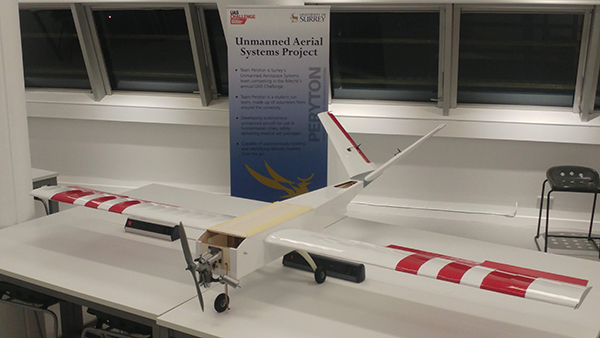Institution news
Register now:
They discuss their achievements to date, challenges encountered and the lessons they have learnt in their quest to design and build an aircraft that could operate in a humanitarian aid mission.
Q: Could you briefly tell us about your team – any interesting facts or background information?
QMUL AirSpace (QA): A multidisciplinary and diverse team made out of members from the QMUL Aerospace society. Disciplines include Aerospace Engineering, Mechanical Engineering and Astrophysics ranging from first year students to third year students. Robotics and Systems Engineers taught postgraduates also make up part of the team.
Team Peryton (TP): This year our team is led by four Masters-level aerospace students, with a wider team of up to twenty volunteers from all years of study and from several departments across the university. Between us, we have accumulated 15 years’ experience in the Institution’s UAS Challenge, with veterans in the team passing on what they have learnt to newer members to improve our capabilities year on year. Our aircraft has a distinctive paint scheme featuring red and white stripes, so we don’t lose it in the sky, also leading to the nickname ‘Wally’!
Q: Could you tell us about the design and innovation aspect of your aircraft?
QA: Fully electrical and autonomous double-wing VTOL drone inspired by the Bell X-22. The innovation aspect of the proposed UAS include the addition of tiltrotors to allow the transition from VTOL to normal cruise conditions, as well as the manufacturing which allowed the assembly and disassembly of the drone.

Team Peryton UAS Challenge 2020 project
TP: Our aircraft has been designed to be quickly and easily assembled at the airfield while being safely transported in a sturdy flight case. The wings and tail slot smoothly into the fuselage, attached with custom-made thumb screws, allowing quick assembly without tools.
Our payloads are fitted with the use of drag flaps, which automatically deploy upon release due to aerodynamic forces. Compared to a parachute, this reduces payload mass and removes the risk of entanglement from parachute cords.
We have also been developing our in-house image recognition system, processing images on-board and giving real time marker identification in flight.
Q: How could your UAV be used to help vulnerable people and fight against COVID-19?
QA: For the current COVID-19 outbreak, our UAV could have been used to deliver face masks, gloves, and even food supplies or other light medical equipment to vulnerable people such as those affected by the COVID-19 or hospitals which might have run out of supplies. The proposed UAV could have easily been deployed from anywhere due to the VTOL capability and the transition to normal cruise condition, which will have allowed a fast delivery of the product. Moreover, the autonomous UAV could have been operated at any time of the day for numerous deliveries and even to give access to vital medical supplies to patients or staff in rural areas in the shortest time possible.
TP: Our aircraft has been designed with payload flexibility in mind. With externally mounted payloads, and hard points under the fuselage and wings, we can provide flexibility in carrying bulkier payloads that would not otherwise fit in the fuselage. The aircraft would be ideal in delivering food packages, testing kits and medicines to vulnerable people in rural isolated areas that would take much longer to reach by road.
Q: What are the key skills you learnt from this project and what were the challenges you faced?
QA: Key skills developed from this project includes:
- Project management
- Budgeting
- Leadership and teamwork
- Creativity, organisation and problem-solving
- Systems architecture and assembly
- Technical skills (i.e. CAD, FEA, CFD), coding, and manufacturing methods (i.e. CAM for CNC Lathe and Milling machine)
Several challenges were faced including the lockdown due to the COVID-19 outbreak which led to closed facilities in our university and prevented the completion of the construction for our drone. Other challenges include adapting the proposed design based on feedback from academic and external mentors to ensure its functionality either by re-designing the proposed model, conducting further performance calculations, and research for autonomous firmware compatible for our drone.
TP: For those of us leaving the team this year with several years’ involvement in the UAS Challenge, we have learnt just how much UAV technology is developing and how this technology has so many practical applications. Working on the team has provided us with invaluable skills in design and development along with practical skills which are applicable to so many areas of engineering. Many thanks to the Institution for hosting the UAS Challenge year after year!
To recognise teamwork done to date, the UAS Challenge organising committee has agreed to host a virtual awards ceremony taking place at 2:30pm on 19 June 2020 to present teams with the following awards:
- Design Award
- Highest Placed New Entrant Award
- Innovation Award
- Business Proposition Award
- Safety Award
- Media & Engagement Award
Registration for the event is now open!